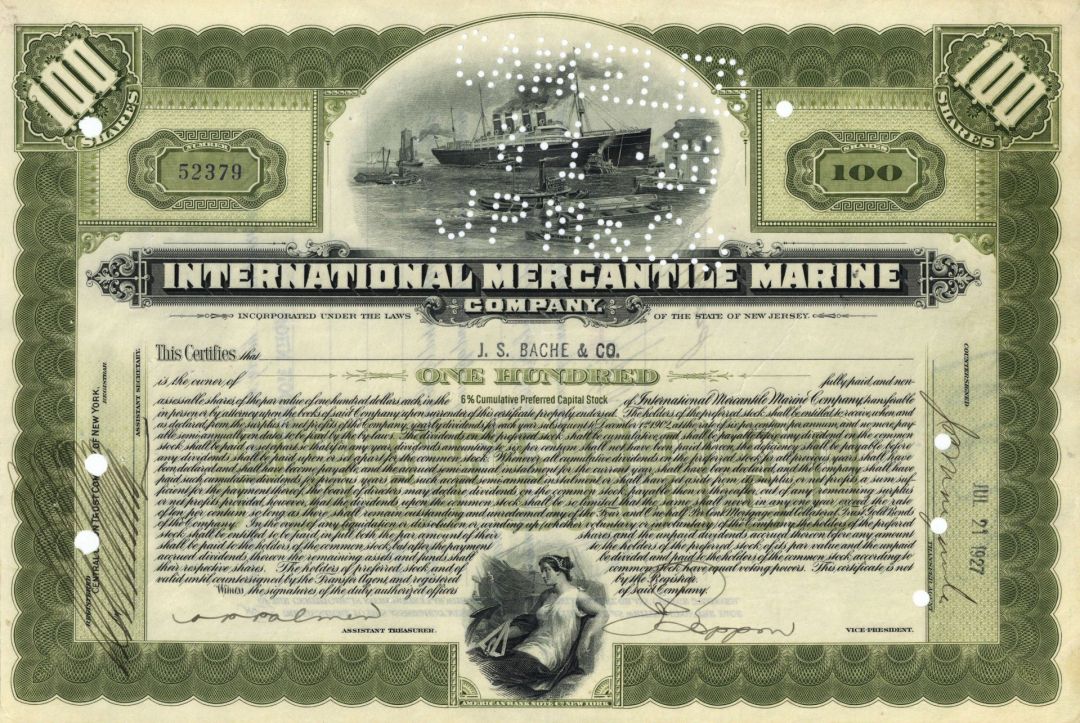International Mercantile Marine Co. - Company that Made the Titanic - 1915-20's dated Shipping Stock Certificate - Available in Green, Purple, Olive or Blue - Please Specify Color Desired
Inv# SS1005 StockShipping Stock. Famous 'Titanic' stock. This organization was the proprietor of White Star Lines and the Titanic. It features a vignette of a ship reminiscent of the 'Titanic' alongside tugboats, as well as an image of a lady with an anchor. Notably, the cancellation of the hole encompasses JPM & Co., which stands for J. Pierpont Morgan & Company. Morgan had control over this substantial enterprise, which ultimately turned out to be one of his less successful investments. The item is available in Green, Purple, Olive, or Blue. Please indicate your preferred color.
The International Mercantile Marine Company (IMM), originally referred to as the International Navigation Company, was a shipping trust created in the early 20th century with the objective of monopolizing maritime commerce. It was established by notable figures in the shipping industry, including Clement Griscom of the American Line and Red Star Line, Bernard N. Baker of the Atlantic Transport Line, J. Bruce Ismay of the White Star Line, and John Ellerman of the Leyland Line. The trust received substantial financial backing from J.P. Morgan & Co., led by financier J.P. Morgan.
IMM also upheld profit-sharing agreements with the German shipping companies Hamburg-Amerika Line and North German Lloyd Line. The establishment of IMM raised concerns within the British shipping sector, prompting a notable reaction: the British government provided subsidies to the Cunard Line for the construction of the RMS Lusitania and RMS Mauretania, with the intention of countering IMM's influence. Since 1902, the International Mercantile Marine Company (IMM) had an arrangement with James Pirrie, the chairman of Harland & Wolff and a prominent figure in the management of the White Star Line, to ensure that all its vessels were built by Harland & Wolff. This partnership guaranteed that IMM's fleet was consistently constructed by the esteemed shipyard.
Furthermore, IMM implemented a strategy of reallocating ships among its various lines. For instance, the SS Belgic, originally designed for the White Star Line, was subsequently transferred to the Red Star Line and renamed SS Belgenland in 1914. Likewise, the Regina was rebranded as the Westernland. This approach enabled IMM to sustain a daily shipping schedule from the United Kingdom and offered passengers the convenience of transferring tickets between different vessels within the company's fleet. Following the incorporation of the Atlantic Transport Line into IMM, Bernard N. Baker stepped down from his position at the Atlantic Transport Line and was succeeded by Philip Franklin, who later became vice president of IMM. Additionally, Joseph Bruce Ismay, the president of the White Star Line, took over from Clement Griscom as president of IMM in 1904.
Before the tragedy of the Titanic, plans were already in place for J. Bruce Ismay to resign from his position as president of the International Mercantile Marine Company (IMM). He was succeeded by Harold Sanderson in 1913. J.P. Morgan passed away on March 31, 1913. After a period of receivership in 1915-16, Sanderson was replaced by Philip Franklin, who had acted as the receiver during the company's financial turmoil. Despite the sinking of the Titanic, the International Mercantile Marine Company did not face immediate dissolution. While it maintained a degree of influence among prominent American, British, and German shipping firms, IMM encountered ongoing financial challenges and was unable to achieve the anticipated dominance in the North Atlantic shipping market.
In 1915, the company entered receivership and came under the management of Philip Franklin, who adeptly guided it through the crisis. In the late 1920s, Franklin obtained government grants for American vessels, whether constructed in the United States or registered under the American flag. In 1926, IMM divested the White Star Line to the Royal Mail Steam Packet Company for £7 million, although £2.35 million of this sum remained unpaid when the Royal Mail Group, which was financially overextended, collapsed in the early 1930s. By 1930, IMM owned 30 ships; this fleet size decreased to 19 by 1933 and further to just 11 by 1935.
A stock certificate is issued by businesses, usually companies. A stock is part of the permanent finance of a business. Normally, they are never repaid, and the investor can recover his/her money only by selling to another investor. Most stocks, or also called shares, earn dividends, at the business's discretion, depending on how well it has traded. A stockholder or shareholder is a part-owner of the business that issued the stock certificates.










Ebay ID: labarre_galleries